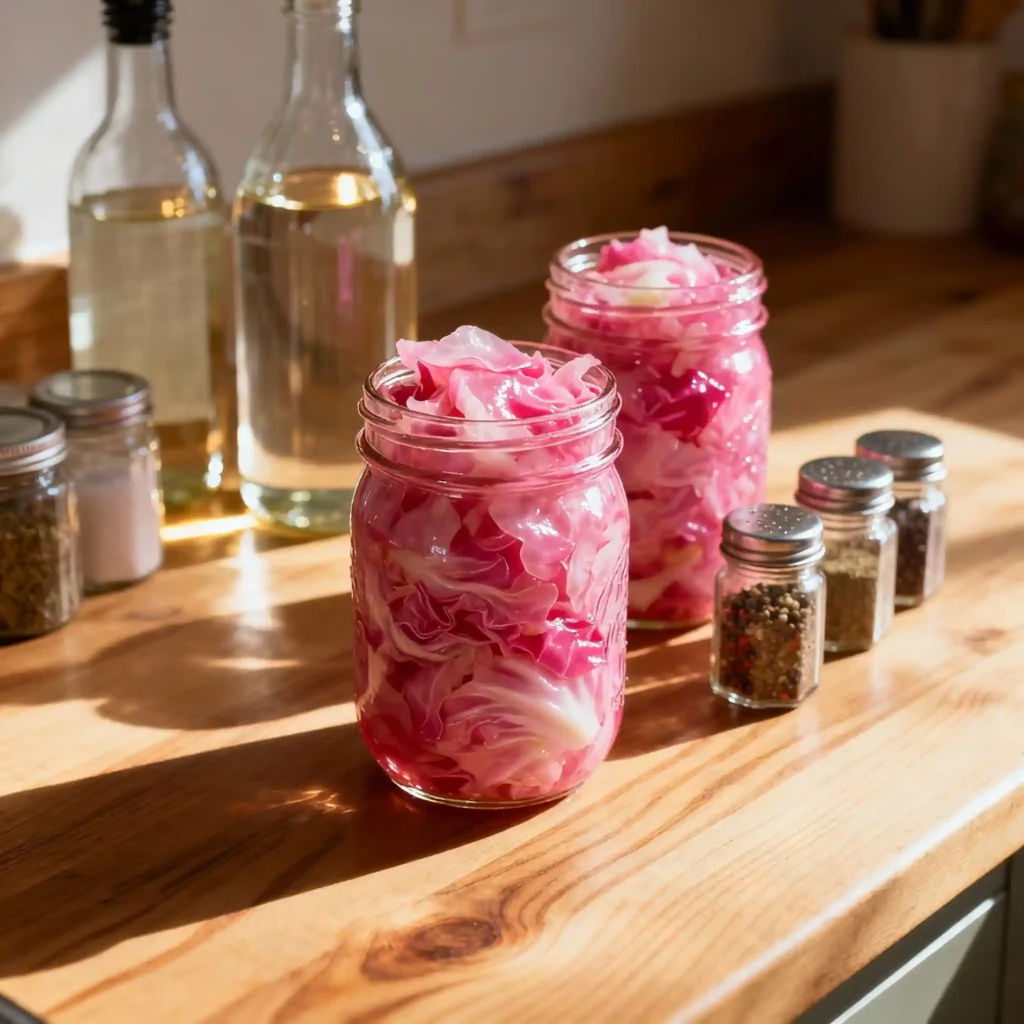
Table of Contents
Table of Contents
Canning pickled cabbage is a timeless way to capture seasonal flavor in jars that last through winter. This tangy, crunchy preserve brightens up hearty meals, from sandwiches to rich roasts. In this guide, you’ll learn how to safely can pickled cabbage at home while keeping it crisp and flavorful. Using acid-based brines ensures safety and great taste for months. You’ll also find a few family-style serving ideas similar to those in our Canning Grape Jelly and Canning Blueberry Jam recipes—both pantry favorites that celebrate simple, homemade goodness.
A Family Tradition of Pickling Cabbage
It all began in my grandmother’s kitchen. Each fall, she would gather cabbage heads from the garden, slice them thin, and fill the house with the briny scent of vinegar and spices. The rhythmic sound of jars sealing on the counter felt like music marking the start of winter. Growing up, I learned that making canning pickled cabbage wasn’t just a process—it was an act of love. Just like I discovered while developing our Pickled Watermelon Rind recipe, preserving food connects us with family traditions that never fade.
The beauty of pickled cabbage lies in its crunch and character. It brings new life to everyday meals, offering the same nostalgic comfort you’ll find in our San Giorgio Lasagna dish that gathers everyone around the table. Each jar tells a story—a reminder that food made with patience stays with you far longer than the season.
Why Pickled Cabbage Deserves a Spot in Your Pantry
Pickled cabbage is both practical and irresistible. It adds bright, tangy flavor to sandwiches, tacos, and dinner plates while extending shelf life safely through vinegar-based canning. According to USDA safety standards, only pickled versions of cabbage are safe for water bath canning, making this one of the easiest and tastiest preservation methods available. The acidity of the brine ensures safety while keeping the cabbage crunchy and full of life.
For a similar balance of flavor and safety, try recipes like Pickle Lemonade for a briny twist or our Japanese Mounjaro Drink for a refreshing contrast to rich preserved foods. These simple creations share the same spirit as pickled cabbage: everyday ingredients transformed into something lasting and delightful.
Step-by-Step Method for Perfect Pickled Cabbage
Preparing the Cabbage: The Foundation of a Good Jar
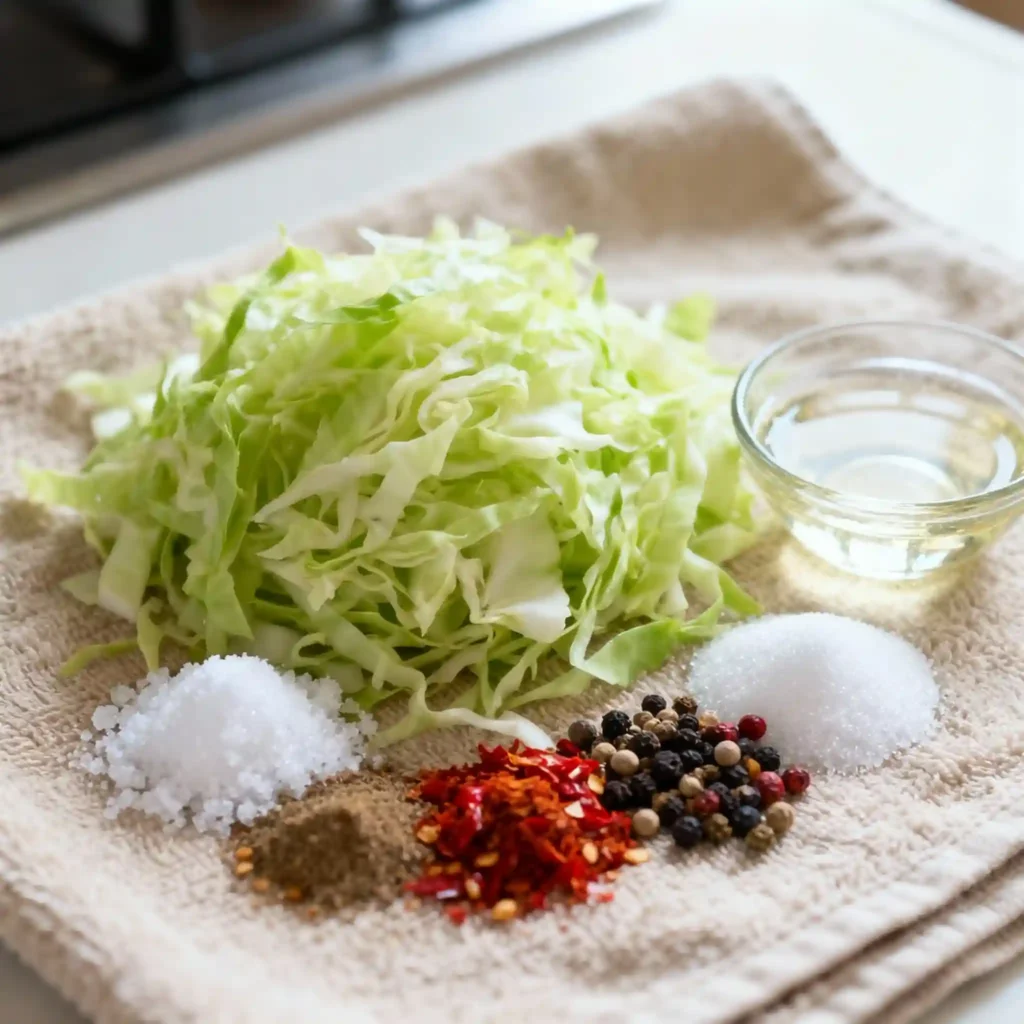
Start with firm, fresh green cabbage. Wash it thoroughly under cool water, remove outer leaves, and slice it thin or shred it finely depending on your preference. For every head of cabbage, sprinkle about two tablespoons of canning salt and let it rest for 30 minutes. This step draws out moisture and helps the cabbage stay crisp after pickling. Rinse and drain well. The salt ratio is essential; experts recommend roughly one and a half tablespoons per liter of brine to balance acidity and crunch.
If you’ve enjoyed making Canning Grape Jelly, the prep process feels familiar—both rely on simple, quality ingredients and patience. Keeping your vegetables dry and clean at this stage sets the foundation for success in all pantry p
Making the Pickling Brine and Sterilizing Jars
The secret behind crisp, flavorful pickled cabbage lies in the perfect brine. Combine 4 cups of white vinegar (5% acidity), 2 cups of water, ½ cup of sugar, and a tablespoon of pickling salt. Bring this mixture to a gentle boil, stirring until the sugar dissolves. Some home canners like adding a touch of mustard seed, celery seed, or black peppercorns for more depth.
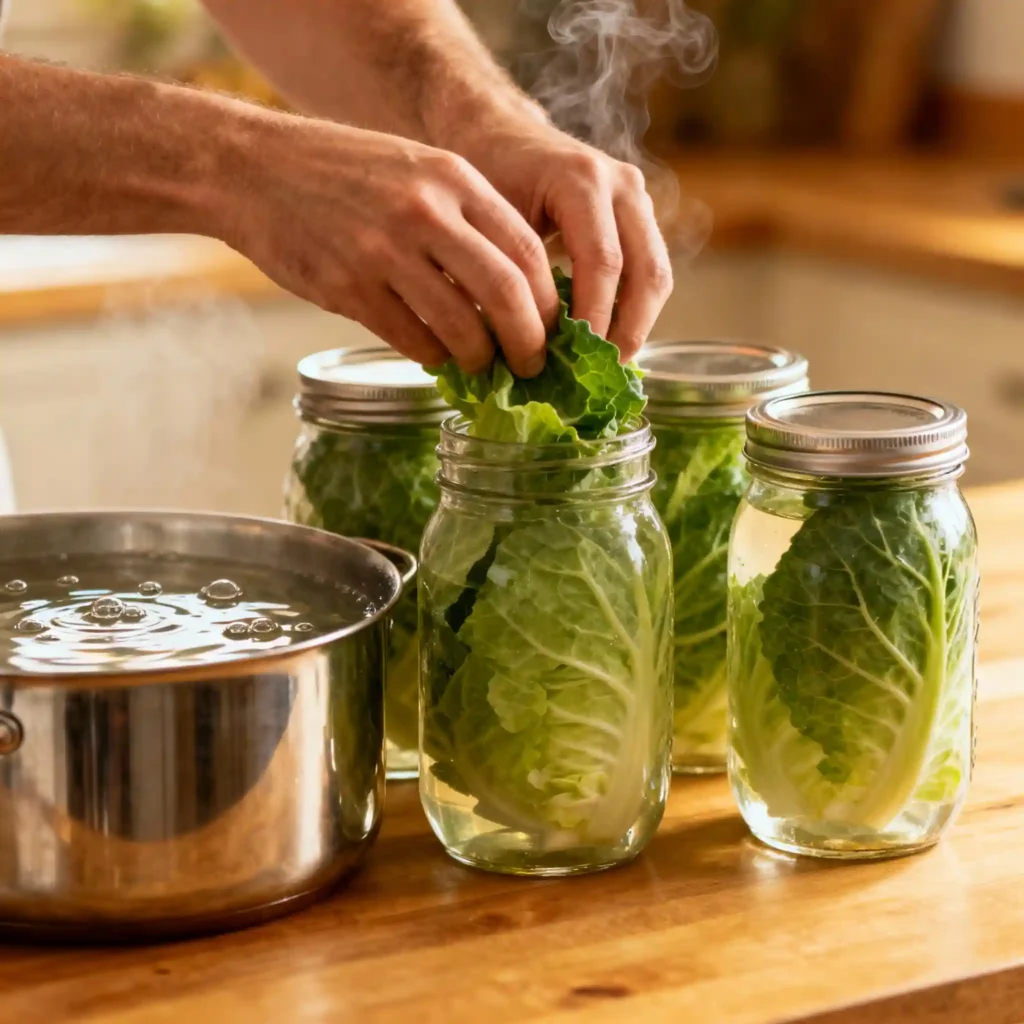
While the brine heats, sterilize your jars by submerging them in hot water for at least 10 minutes. Hot jars prevent temperature shock once filled. If you’ve read our Canning Blueberry Jam article, you’ll notice the same principle—sterile equipment is key to safe storage and sealed freshness.
Packing the Jars for Crisp Results
Once your jars are ready, pack the salted cabbage snugly but not too tight. Pour the hot brine over the cabbage, leaving ½ inch of headspace on top. Add a pinch of Pickle Crisp, if available, to preserve texture and prevent the cabbage from softening. Wipe each jar rim clean, then apply the lid and twist the band to fingertip tightness.
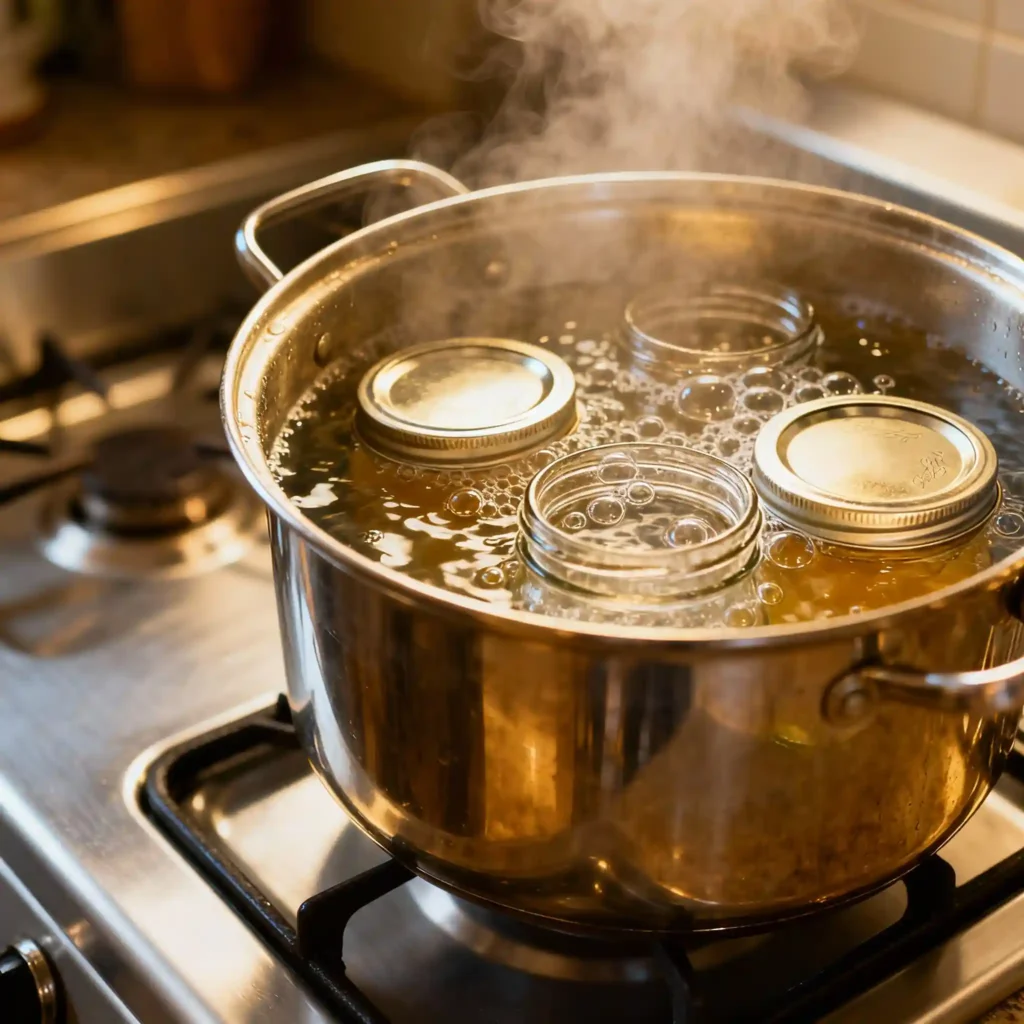
According to safe canning guidelines , jars should be placed on a rack in a boiling water bath canner with at least one inch of water covering the tops. Bring to a rolling boil and process for 20 minutes (25 minutes at higher altitudes). Once done, remove the jars and let them cool undisturbed for 12 hours. Check seals before labeling.
For more comfort kitchen inspiration, look at Mushroom Poke for a savory pairing or our San Giorgio Lasagna to complement your tangy pickles at dinner.
Cooling, Storing, and Shelf Life
After cooling, store sealed jars in a dark, cool place for up to a year. Unsealed or opened jars should be moved to the fridge and eaten within a few weeks. Pickled cabbage improves with age, developing deeper flavor each month. The vinegar and salt combination prevents spoilage while keeping the cabbage’s natural color bright.
Canning experts suggest patience—flavors round out beautifully after two weeks. Pair your new jars with meals like Pickle Lemonade for a bold flavor twist, or enjoy them on the side of hearty entrées featured in your own About Taste Our Dish section, where storytelling and home flavor come together.
Serving Ideas & Flavor Variations
Creative Ways to Enjoy Pickled Cabbage
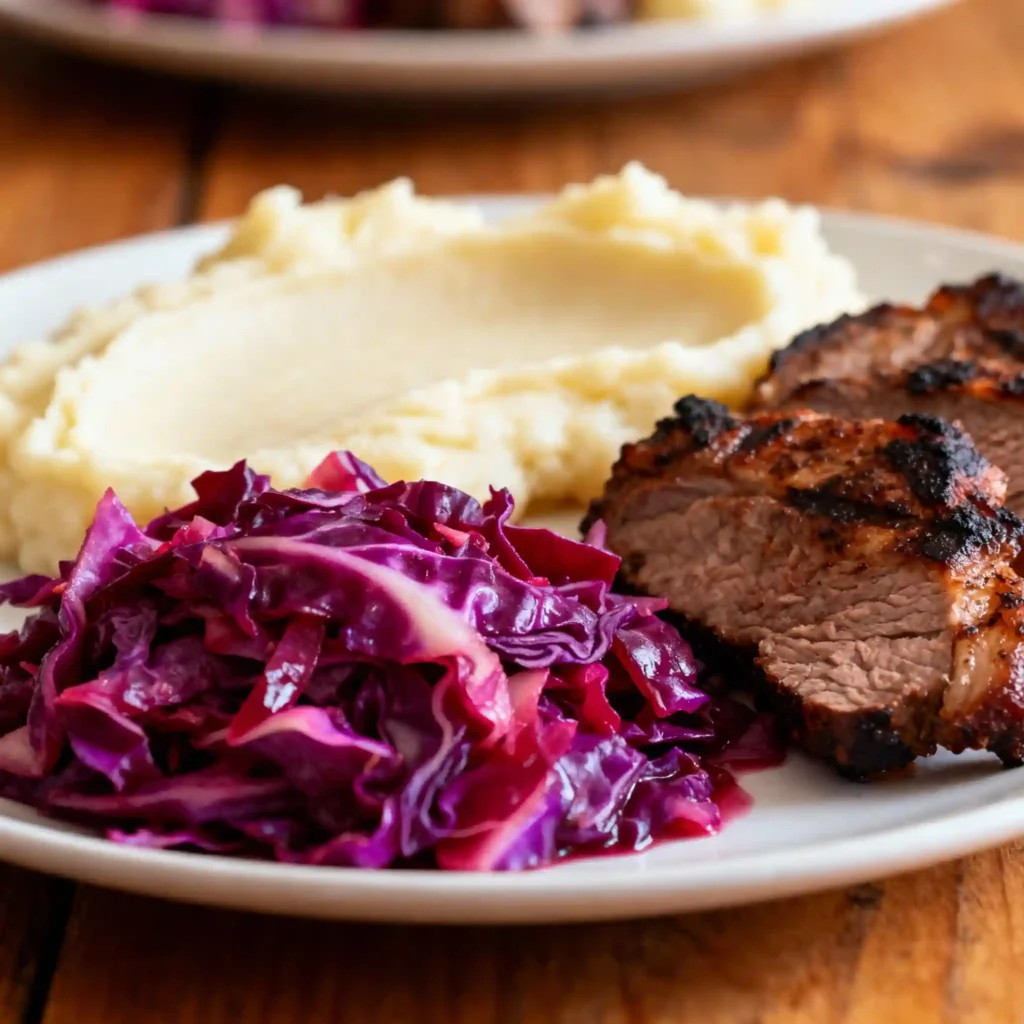
Pickled cabbage isn’t just for storing—it’s for serving in vibrant, flavorful ways throughout the week. Its crisp texture and tangy flavor pair beautifully with grilled meats, wraps, and salads. You can use it to add brightness to fish tacos, pulled pork sandwiches, or even your favorite rice bowls. Many cooks love tossing a spoonful of pickled cabbage into grain bowls or topping burgers for a refreshing crunch.
If you’re looking for hearty dinners that complement your preserves, try pairing with Canning Blackberry Jam Secrets for a sweet-savory contrast or layering it beside our San Giorgio Lasagna Recipe—both create a balanced meal that’s comforting yet lively. A well-made jar of cabbage can transform these meals with little effort.
Side Dishes and Pairing Inspiration
For simple family dinners, serve your pickled cabbage alongside roasted chicken, grilled sausages, or baked pork chops. Its acidity cuts through rich dishes, adding extra brightness to your plate. Many readers also enjoy mixing it into potato salads or spooning it over mashed potatoes for added crunch. Another fun idea? Stir some into soups during winter—its vinegar base perks up slow-cooked flavors without changing textures.
Craving something less traditional? Add a small scoop of pickled cabbage to your Mushroom Poke Recipe or Pickle Lemonade Recipe for a surprising flavor twist. These crossovers link sweet, sour, and umami profiles that awaken your palate in unexpected ways, showing that canning can lead to endless creativity in everyday cooking.
Regional Twists & Homemade Variations
From tangy Korean-style cabbage used in BBQ to Eastern European versions served with dumplings and sausages, each culture has its own take on this pantry staple. You can customize your own pickled cabbage by adding ingredients like grated carrots, garlic, onion, or even sweet peppers for color. A dash of chili flakes or ginger gives your jar a subtle, spicy edge without overpowering the cabbage’s natural crunch.
For inspiration rooted in home-cooked flair, check out Bariatric Pumpkin Seed Recipe or Canning Grape Jelly—both grounded in the idea of turning simple produce into lasting nourishment. Much like those recipes, pickled cabbage thrives on balance: flavor, texture, and freshness in harmony.
Pro Tip: Preserving Crunch and Color
To keep that irresistible snap, avoid over-processing. Instead, ensure your brine is hot enough to preserve freshness but not so intense that it softens the leaves. Store canned jars in a cool, dark place and chill them before serving to heighten their flavor. When opened, always make sure the cabbage stays submerged in the brine—it helps maintain color and texture over time.
Add this as a staple next to your Canning Blueberry Jam for a colorful pantry shelf or pair it with your About Taste Our Dish story section to give readers background on how preserving food connects generations and builds memories in the kitchen.
Frequently Asked Questions
Is it safe to can pickled cabbage?
Yes, absolutely—as long as you follow tested recipes that include enough vinegar to maintain acidity. Pickled cabbage is considered high-acid food because the vinegar prevents harmful bacteria like Clostridium botulinum from surviving. However, plain cabbage that isn’t pickled cannot be safely canned at home. The USDA confirms that only pickled or fermented cabbage is approved for hot-water canning because the added vinegar ensures food safety.
For more safety tips like these, check out your own Canning Grape Jelly and Canning Blueberry Jam guides—both rely on the same science of acidity for safe long-term storage.
How do you can cabbage properly?
You can safely can cabbage by preparing it as a pickled recipe. Start with clean, shredded cabbage and pack it into sterilized jars. Pour over a hot brine of vinegar, water, sugar, and salt, then process in a boiling water bath for about 20 minutes. This heat treatment kills remaining bacteria and seals the jars tightly. Remember to let jars cool undisturbed for at least 12 hours before storing them.
When ready to serve, pair it with hearty dishes already featured on your site such as San Giorgio Lasagna Recipe or experiment by spooning it over our Mushroom Poke Recipe for a tangy bite that brightens rich meals.
How do you pickle cabbage at home?
Pickled cabbage starts with a simple brine—combine equal parts vinegar and water, add salt and spices, then bring to a gentle simmer. Pour the brine over shredded cabbage, seal, and process jars in a hot-water bath canner for safety. You can also refrigerate non-canned jars for quick use within a few weeks. Adjust seasonings by adding garlic, peppercorns, mustard seeds, or even chili flakes for flavor depth.
Readers who love refreshing flavors will also enjoy your Pickle Lemonade Recipe and Japanese Mounjaro Recipe—both show how vinegar-based recipes can be bright, bold, and good for gut health.
How can you preserve cabbage long-term in jars?
The safest long-term preservation method for cabbage is pickling with proper vinegar acidity (at least 5%) before canning in boiling water. Pickled cabbage stored in a cool, dark place stays fresh for up to a year, while refrigerated opened jars should be eaten within a month for best flavor. If pickling isn’t preferred, freezing is another safe method; it retains color and nutrition while extending shelf life.
To explore more pantry preservation options, see your Canning Blackberry Jam Secrets page and Bariatric Pumpkin Seed Recipe—both demonstrate how simple kitchen steps can lead to lasting nourishment.
Conclusion
Canning pickled cabbage connects generations through taste and tradition. The process is simple, rewarding, and perfectly safe when followed correctly. Every jar adds a pop of color and crunch to your pantry while letting you preserve the essence of fresh produce all year long. Whether enjoyed beside comforting classics or bold new dishes, each batch reminds you that homemade food doesn’t just fill jars—it fills hearts. For more cozy seasonal projects, revisit your About Taste Our Dish section to share stories of love, learning, and food that feels like home.
Print
Canning Pickled Cabbage: A Simple, Safe, and Delicious Way to Preserve Crunch
- Total Time: 45 min
- Yield: 6 pint jars
- Diet: Vegan
Description
A crisp, tangy pickled cabbage recipe perfect for canning all year long. Safe, tested, and easy to customize for color and spice levels.
Ingredients
1 medium head fresh cabbage (green or red)
2 cups white vinegar (5% acidity)
1 cup apple cider vinegar
1 1/2 cups water
1/3 cup sugar
1/3 cup canning salt
1 tbsp mustard seeds
1 tbsp peppercorns
2 garlic cloves (optional)
1 tsp caraway or dill seeds (optional)
Pickle Crisp (optional, for texture)
Instructions
1. Wash and core cabbage. Shred finely using a knife or mandoline.
2. Sprinkle cabbage with 2 tbsp canning salt and let rest for 30 minutes, then rinse and drain.
3. In a large pot, combine vinegars, water, sugar, and salt. Bring to a gentle boil until sugar dissolves. Add spices.
4. Sterilize jars by boiling them for 10 minutes or keeping them hot in simmering water.
5. Pack cabbage snugly into hot jars, leaving 1/2-inch headspace.
6. Ladle hot brine over cabbage. Add Pickle Crisp if desired. Remove air bubbles, clean rims, apply lids finger-tight.
7. Process in boiling water bath canner for 20 minutes (pints) or 25 minutes (quarts). Adjust for altitude if needed.
8. Remove jars, cool 12 hours untouched. Check seals before storing in a cool, dark pantry.
Notes
You can adjust the spice mix to include chili flakes or coriander for extra flavor.
Lightly sweet or savory styles both work well—taste the brine before adding to jars.
Always use vinegar with 5% acidity for food safety.
If jars don’t seal, refrigerate and consume within 1 month.
- Prep Time: 20 min
- Cook Time: 25 min
- Category: Canning Recipes
- Method: Water Bath Canning
- Cuisine: American Home Canning
Nutrition
- Serving Size: 1/4 cup
- Calories: 25
- Sugar: 3g
- Sodium: 180mg
- Fat: 0g
- Saturated Fat: 0g
- Unsaturated Fat: 0g
- Trans Fat: 0g
- Carbohydrates: 5g
- Fiber: 1g
- Protein: 1g
- Cholesterol: 0mg


